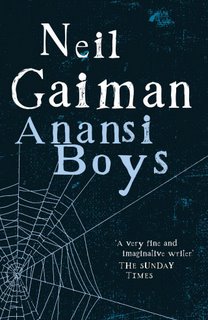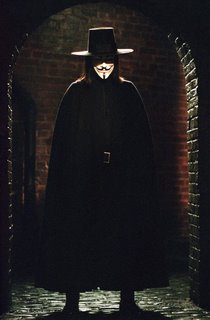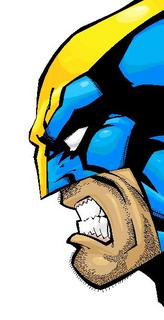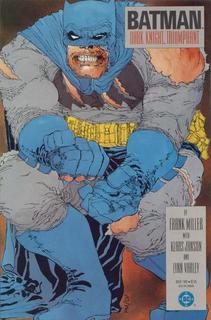
Profoundly moving. Not sure I can add much to the reams that have been written about it – if you’re interested you can start at the wiki page here.
Category Archives: graphic novels
Spider Jerusalem
If you go here you’ll be able to read an issue of Transmetropolitan, the journal of the future-journalist Spider Jerusalem, created by Warren Ellis. BE WARNED – MATURE CONTENT!!!
But it is mature content with a social conscience, and an important point. That’s why Mr Jerusalem is my hero.
“Because you wouldn’t have it any other way”
V for Vendetta
Neil Gaiman on comics and film
The genius opines here.
Like him, I’m looking forward to V for Vendetta being released. Especially given my last two posts…
Anansi Boys – Neil Gaiman

Long time readers of the blog will be aware that I consider Neil Gaiman to be a genius. Anansi Boys is his latest novel, and it follows on from American Gods in its exploration of magical realism and fantasy. It centres on Fat Charlie, a rather sad individual who seems to be fated to a life of boredom and ill luck, until he goes to his (estranged) father’s funeral in Florida. Here he discovers not only that his father was in fact Anansi the spider god, but that he also has a long-lost brother, Spider. Fat Charlie calls his brother back into his life, whereupon Spider proceeds to cause utter chaos, taking over Fat Charlie’s life – including his job and his fiancee… Fat Charlie (who isn’t fat by the way) seeks help from some of the other gods, and gets into deeper waters than he bargained for.
This was great fun, very readable (I stayed up to read it in one sitting – one of the pleasures of reading whilst on holiday) and satisfying as a story. The one caveat I have is that it seemed to be reprising some of the Sandman points in a minor key – Anansi being the weaver of stories in the same way that Morpheus is. The novel doesn’t have the psychological or theological depths that the Sandman sequence attains, but it doesn’t aim that high. It’s simply a good story, enjoyably told. A good place to begin reading Gaiman if you are unfamiliar with his work.
Rage, and comic book heroes
I thought I’d say something about the words beneath my profile, ie “The truth will set you free” and “Spider Jerusalem is my hero”. Well, the first should be an obvious reference for most readers, and it encapsulates how I understand my faith. But the second may need a little explanation…
Apparently comic book superheroes have replaced the different gods of previous mythologies. Where once the imagination of a child was filled with stories of Hercules, now they have Spiderman. Seems plausible to me.
I read comics a lot when I was a child. I read comics a lot now, but they’re rather different. When I was about 9 my hero was the Hulk. Imagined like this:
Then when I stretched into the teenage years, Wolverine took over – he was a sharper character:
And then when I was in my twenties Frank Miller’s Batman was the one I resonated with:
Two things. The first is that what strikes me now is how angry I was. Just look at the expressions on their faces. Rage. I think a lot of men (boys) have that rage, which is why comics are so popular in certain quarters. It might do the world some good to ponder the roots of that rage. But second, the most interesting ‘comic book’ hero that I identify with now is a man called Spider Jerusalem, from Warren Ellis’ series called Transmetropolitan.
Now, a word of warning – this is not for the squeamish, and probably shouldn’t be read by anyone who considers themselves a Christian – it’s rude, lewd, frequently blasphemous and obscene, and frankly I’m worried about myself for enjoying it so much. But I enjoy it because it is laugh-out-loud funny and I think Spider represents something essential about humanity – he’s awful, but he’s dedicated to the truth. And I think that’s important. He is redeemed by his acceptance of the truth. I suspect that applies to me too.
The thing is, he’s a tremendously angry man. His column in the newspaper/blog is “I hate it here” and the one consistent thing that drives him is his rage against the world. But his rage has a productive outlet – blog articles which expose the powers that be.
I’m not there yet.
But I’d like to be.
That’s what heroes are for aren’t they? – they represent those bits of you that seek expression, and the worship of the hero is what enables those bits of yourself to articulate themselves and, hopefully, come out. (Which is why Christ is the ultimate hero who can’t be replaced – but that’s another post).
This is Spider’s philosophy:
“Let me tell you how it is going to be.
I am free to write what I want, when I want. And you have to come to me to read me.
This is not the same deal as picking up a newspaper for the sports and the TV listings and getting a piece of me too.
You actually have to sit down and poke your feedsite reader and come to me.
And I will tell you things that will make you laugh and I will tell you things that make you uncomfortable and I will tell you things that will make you really fucking angry and I will tell you things that no one else is telling you.
What I won’t do is bullshit you.”
I think that’s the only promise a blogger should make. And I shall try very hard to live up to it.
Sin City
Go, go, go, said the bird: human kind
Cannot bear very much reality
Last week was a heavy week, in all sorts of ways, most of which can’t be discussed here. My response to too much reality is always to seek refuge in something fantastical, either in a film, a graphic novel or in books (fantasy or SF). Hence my love of Neil Gaiman’s Sandman sequence (big post brewing on that particular subject, coming here soon). Fantasy keeps me sane; it takes me out of myself (ec-stasy); it means that I have some fuel in my tank when I need to take up the burdens of reality once again.
Yesterday was my day off, so I indulged myself fully and went to see TWO films – Sin City, and Batman Begins. I might talk about Batman another time (it was excellent – probably the best Batman adaptation) but for now, a few words about Sin City.
For those of you unfamiliar with Frank Miller, he’s primarily a comic book writer/artist who revolutionised the genre with a remarkable reworking of the Batman mythos in his ‘The Dark Knight Returns’, which came out in the mid/late 80’s. Forget the idea that comic books are for adolescents; Miller is very sharp, and very political.
Now ‘Sin City’ is a sequence of graphic novels (that’s the ‘correct’ term for comics-read-by-adults) drawing on some of the staple noir elements – hard-bitten ex-cons, troubled cops, prostitutes with hearts of gold etc – but putting them through a particular stylisation which makes the contrasts incredibly stark, and which Miller sought to have reflected through a very spare visual vocabulary – lots of heavy black blocking, outline drawing of characters, almost no colour. And Robert Rodriguez has faithfully reproduced that style in his film; it was very effective.
I started reading the Sin City graphic novels a few years ago. I don’t enjoy them as much as his Batman work, because the raw material that he is dealing with is uncompromising and very violent. At this point, there may be the question: is this something that a priest should be reading? (or watching?) Isn’t it anti-Christian in some way? (Heavens, if Harry Potter is considered anti-Christian, then Sin City is enough to make such maiden aunts have heart attacks…. These are the people who want to restore the Levitical purity codes.)
This is something I’ve been musing on a bit recently – it came up in a confirmation class last week. So I thought I’d say a few words about why, despite the occasional qualm, I don’t have a great problem with spending time in Sin City.
To my mind, the issue about any work of art, from a Christian point of view, is whether it is orthodox or not. Now I use orthodox here in a particular way. I don’t mean ‘has it signed up to saying “Jesus Christ is my personal Lord and Saviour”?’ I mean ‘is it informed by the resurrection’? Which I take to mean: are there signs of grace, forgiveness, redemption and hope? Or is it a work characterised by the opposite of the resurrection, which is nihilism, which is characterised by the absence of meaning, the denial of hope, the embrace of corruption and the elevation of inhumanity into a model to be emulated? Is death seen as the final evil, or are there ways in which death is overcome?
For it seems to me that the structures of the world, the principalities and powers (Eph 6) to which we must forever be opposed are built upon the contention that death is the final evil which must be resisted. The resurrection is what demolishes those principalities and powers precisely because it says that we do not need to be quite so afraid of death; that there are things which death cannot touch; and that our life and our hope lie in the resistance, not necessarily the overcoming. (That’s what it means to live eschatologically, in the light of the end time.)
Sin City seems to be a world where – to put it no more strongly – orthodoxy is possible. It is a portrait of a corrupt world, where the principalities and powers are overwhemingly present, and where the suffering that follows is rendered starkly. Yet in the face of these powers, there is redemption and love and self-sacrifice, rendered most obviously in the film through the character-arc of the Bruce Willis character, where any Christian will recognise a copy of the original Story.
“An old man dies, a young girl lives. Fair trade.”
Perhaps it’s the imaginative portrayal of reality in fantasy that makes the reality itself tolerable. The fantasy equips the mind with the tools that enable the reality to be digested, rendered meaningful. Is this not the shield of faith (Eph 6.16) with which we can overcome the world? The link between imagination and faith is intimate, and the nurturing of our imaginations is a Christian task. Just ask Walter Brueggemann.
Two final points.
One. If Christians are not to spend time in Sin City, for fear of being corrupted by the violence and debauchery, then they must also close the pages of the Old Testament. Nothing in Sin City is as shocking as, for example, Ezekiel 16.
Two. Sin City is the abode of those whom society has rejected. The sinners, the outcast, the prostitutes. I have no doubt that Jesus would choose to spend his time in Sin City. There live the ones who recognise Him for who He is.
Those interested in exploring some of the theology underlying this post are directed towards ‘Faith Beyond Resentment’ by James Alison, especially the final chapter, ‘The Boys in the Square’.




